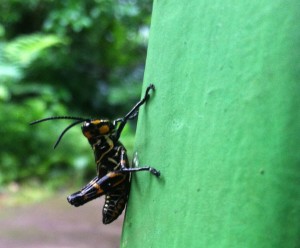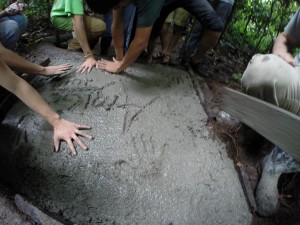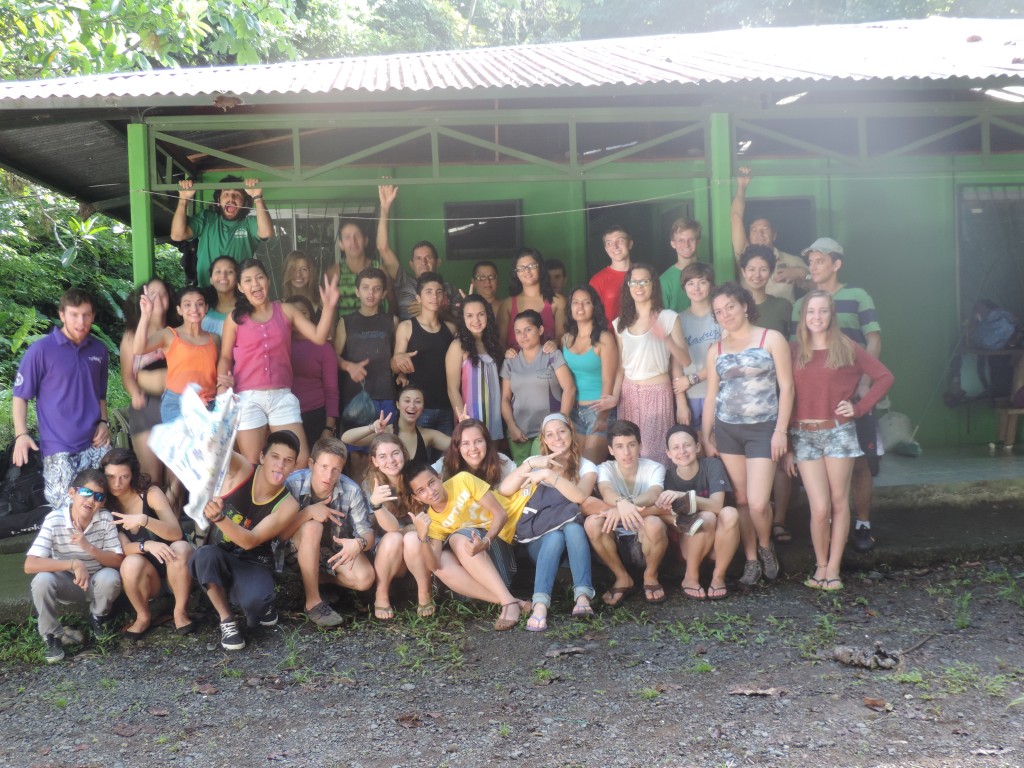In the tangle of cacophonous green that is Carara National Park, two types of forest meet, a mix of plants, animals and insects found nowhere else in the world.
This convergence of Costa Rica’s dry Northern Pacific region and its much wetter Southern Zone is host to half the known animal species in a country famed for prodigious biological diversity. For a while this year it was also host to an unlikely combination of young people, half from the United States and half from Costa Rica, all volunteers.
This group arrived at Carara much to the discomfort of an iguana family that had taken up residence in the bunkhouse. The impressive green lizards stomped around the metal roof and glared from the rafters as the people set to work building infrastructure and breaking down cultural barriers during week-long “campamentos.”
Throughout July, six of these work parties were organized at three national parks through a not-for-profit partnership between youth leadership organizations Casa de La Juventud of San Isidro de General, Perez Zeledon, and AMIGOS de las Americas, headquartered in Houston, Texas. During the project, 14- to 29-year-old volunteers from the U.S. and Costa Rica were overseen by slightly older AMIGOS supervisors and CASA coordinators, who reported to a pair of project directors under 30.
“It’s a very egalitarian organization, where everyone’s point of view counts,” said Airon Corrales Vargas, a 26-year-old coordinator from Tambor, Perez Zeledon.
Airon is a student and teacher at La Universidad Nacional, who first got involved with this program after AMIGOS worked in his hometown. His family has hosted numerous North American volunteers over the years.
Typically, AMIGOS partners with organizations in Latin American countries to place young people from the U.S. with unpaid host families in rural communities like Tambor, where they spend two or three months working on a project identified by the locals. These projects take as many forms as there are places in the organization’s network, from improving public spaces to developing after-school programs. Spanish language skills are a must for participants. Costa Rica is distinct from other AMIGOS programs in that it is the only country in which volunteers leave the host communities to work alongside local youth within a national park system.

One group tarried along the trail at Carara during a morning hike. It crossed a bridge and descended concrete stairs built by the prior campamento. A few people rested under a recently repaired shade structure as a venomous toad hopped out of sight.
“Look!” breathed Jeffry Lopez Navarro, a 14-year-old from San Carlos, Perez Zeledon, redirecting all eyes upwards to where two dark forms clung to a trunk many stories overhead.
“The one way above is a bird’s nest and the one below it is a bee hive.”
In Carara tall trees like this cut straight to the heart of a tropical sun, while an array of shade-loving shrubs blanket the spongy forest floor, a melange of rotting stuff laced in delicate fungal mycelia. In between grow the epiphytes, plants that live on other plants. Even with all 36 campamento participants stomping along, it was hard to look into the vegetative weave without seeing something move. Human ears attuned to the dart of lizards, the yowl of monkeys, the flutter of butterflies, the flapping of wild turkeys or the total silence of a huge spider, ever wakeful on its low-hanging web.
Then came the sloth, seemingly caught mid-chew as it gazed down from the highest reaches of a tree. Unmoving and camoflauged by a symbiotic moss that grows on its gray coat, it looked a lot like a branch with eyes.
Meanwhile, a termite colony ceaselessly sculpted fallen wood. Hundreds of black caterpillars folded into the creases of a wild cashew tree. “Maybe doing something reproductive,” someone guessed. And the ants. Everywhere ants: boring into packed red earth, clipping tons of electric green leaf matter and carrying it home over the 12-lane micro-super-highways that crossed the trail.
“Those ants carry leaves back home, where they turn it into food, a kind of fungus the colony eats,” explained 23-year-old Allan Chinchilla Naranjo.
After the hike he leaned against the wall in the common area of the bunkhouse, musing about Carara and what it’s like to have two volunteers from the U.S. live with his family in San Pablo, Perez Zeledon, where they grow sugar cane and coffee.
“Of course there are things that are difficult. Understanding each other, for example, because they are learning the language. But the girls came to my house and became like my sisters, like my nieces and my cousins,” he said.
For Allan, this experience dismantled a lot of stereotypes.
“We thought all Americans eat a lot of McDonald’s, but in reality McDonald’s is everywhere. The girls seem to like typical Costa Rican food, you know, rice, beans, plantains and salad,” he said.
But for Lizzie Mombello, a 17-year-old volunteer from Kansas City, Missouri, many of the stereotypes she heard about Costa Rican culture are panning out.
“I read a lot of articles before the trip, which described Ticos as polite, generous, loud and knowledgable about their country. That all seems true. Though, even in the US, every state, every place is different and I am learning that here,” she said.

The trip to Costa Rica was her first time on an airplane, her first time away from her own family.
“Luckily, my Tico family is very similar in a lot of ways. I have three siblings at home and my family here has three siblings. The house gets loud and there is always something happening,” she said.
And if there was a dull moment at Carara this reporter did not see it.
In addition to widening three kilometers of trails, moving more than 400 rocks the size of coconuts, shoveling untold amounts of organic debris, pouring concrete, mending a roof, wielding machetes with aplomb, repairing wooden railings and cleaning choked gutters, the group made time to play, to plan, to name the iguanas and some of the rocks, too.
During Lizzie and Allan’s week, fellow volunteers created an obstacle course. As the designers gleefully explained its requirements, the sky opened up, drenching everyone to the bone. Veins of mud flowed where there were once paths. The undaunted took their marks, rain only cheering them on.
Imagine the full force of heaven upon you as you hold a silver spoon in clenched teeth, balancing a lime on the end and walking through a muddy ditch. Then jump into a barrel full of dirty water, belly crawl under a wire through a gravel trench, high-jump halfway up a tree, spin around a broom stick ten times and in this state try to kick a soccer ball through a goal no wider than an umbrella. Next, scramble barefoot up a 30-degree slope slicked by plastic and soap, then tie one of your ankles to your partner’s and hobble 50 or so meters. Hooray! You made it to the finish line! But this is not so much a symbolic tape to be victoriously dashed through as a high, taut rope to be jumped over, using only your partner for help.
There was some confusion over which team won this race, dreamed up by a commission of six volunteers tasked with planning recreational activities during the week. Other commissions facilitated training in first aid, tool use, cultural education and multimedia projects. They all took turns organizing nightly meetings or “asambleas,” and helping the volunteer cooks from Perez Zeledon prepare for and clean up after meals.
“We try to put the campamento in the hands of the volunteers,” said Alessandro Broido, a Texas-born 25-year-old Senior Project Supervisor with AMIGOS and the only paid participant at the campamento.
“The intention is to create an inclusive space where everybody can express their ideas and share whatever they want to bring to the table,” he said.
After the obstacle course, mud streamed from clothes, skin, hair, smiles. Some people took showers, others just stood in the downpour until it rinsed them cleanish. That night Lizzie reflected on the experience, chunks of dirt mooning under her fingernails.
“Every person has different capabilities. For some people jumping over the rope was easy, for others it was running up the slide. Everyone comes from a different place and that’s what makes them who they are. A lot of my being here is about helping me find myself, about finding out what fascinates me. I think that is people and language.”
-Emily Jo Cureton

